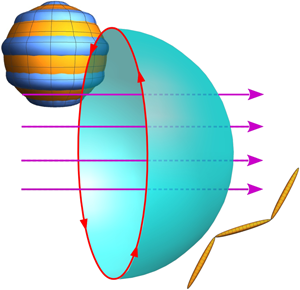Article contents
Geometric phase methods with Stokes theorem for a general viscous swimmer
Published online by Cambridge University Press: 06 April 2021
Abstract

The geometric phase techniques for swimming in viscous flows express the net displacement of a swimmer as a path integral of a field in configuration space. This representation can be transformed into an area integral for simple swimmers using the Stokes theorem. Since this transformation applies for any loop, the integrand of this area integral can be used to help design these swimmers. However, the extension of this Stokes theorem technique to more complicated swimmers is hampered by problems with variables that do not commute and by how to visualise and understand the higher-dimensional spaces. In this paper, we develop a treatment for each of these problems, thereby allowing the displacement of general swimmers in any environment to be designed and understood similarly to simple swimmers. The net displacement arising from non-commuting variables is tackled by embedding the integral into a higher-dimensional space, which can then be visualised through a suitability constructed surface. These methods are developed for general swimmers and demonstrated on three benchmark examples: Purcell's two-hinged swimmer, an axisymmetric squirmer in free space and an axisymmetric squirmer approaching a free interface. We show in particular that, for swimmers with more than two modes of deformation, there exists an infinite set of strokes that generate each net displacement. Hence, in the absence of additional restrictions, general microscopic swimmers do not have a single stroke that maximises their displacement.
- Type
- JFM Papers
- Information
- Copyright
- © The Author(s), 2021. Published by Cambridge University Press
References
REFERENCES
- 4
- Cited by



